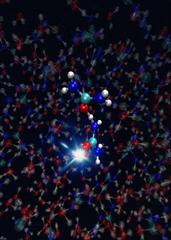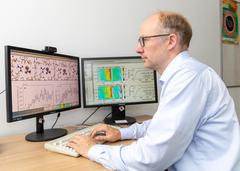URL: https://www.desy.de/news/news_search/index_eng.html
Breadcrumb Navigation
DESY News: High-speed proton transaction
News
News from the DESY research centre
High-speed proton transaction
How did life begin on Earth? Experts have long been fascinated by this question and over the years have come up with a variety of theories. One hypothesis is that the origin of life can be traced back to warm little ponds which are thought to have existed on Earth four billion years ago. The water in these ponds probably contained urea molecules; these were exposed to ultraviolet radiation from the sun, which at that time would have penetrated to the surface of the earth largely unimpeded. This high-energy radiation was able to convert the urea into reaction products which then formed biomolecules that later served as the building blocks of life – or so the idea goes.

Two neighboring urea molecules in an aqueous solution exchange protons. Credit: DESY, Ludger Inhester
For their experiment at the University of Geneva, the team shot pulses of a laser beam through a jet of a highly concentrated urea solution. The laser pulses ionised some of the urea molecules, knocking one electron out of each of them. Immediately afterwards, the scientists sent an ultra-short pulse of soft X-rays behind them. These acted as a probe, revealing in great detail how the urea reacts to the electron being knocked out. The group then repeated the experiment several times, systematically changing the time interval between the ionising laser and the X-ray pulses.
As a result, it was possible to reconstruct the sequence of events precisely – down to a few femtoseconds (quadrillionths of a second). Interpreting the resulting spectra proved to be particularly challenging. “This required detailed computer simulations which we developed here at DESY over many years,” explains DESY physicist Ludger Inhester, who works at the Center for Free-Electron Laser Science, a joint venture of DESY, the University of Hamburg an the Max Planck Society.

DESY scientist Dr. Ludger Inhester. Credit: DESY, Marta Mayer
The experiment carried out by the scientists not only demonstrates for the first time the rapid “proton transaction” concluded between two urea molecules, but also reveals its duration – the entire process takes just a few hundred femtoseconds.
“What is new about our experiment is that we were able to observe extremely fast processes in a molecule that exists in an aqueous environment,” explains Inhester points out. “Previous experiments have only looked at reactions like this in the gas phase.” The behaviour of molecules suspended in a liquid such as water is particularly relevant to a whole number of questions – especially when it comes to biological processes. Experiments in this type of environment are a challenge not only when it comes to making the measurements, but also in terms of the computations required to interpret the measured data.
In future, the new technique might also reveal the details of what happens when ionising radiation strikes tissue, causing radiation damage – the type of research that the new Centre for Molecular Water Science (CMWS) envisages doing, that is currently being set up in international cooperation on the DESY campus. The researchers are also toying with the idea of conducting similar experiments at a far larger X-ray source, the European XFEL in Hamburg. This X-ray laser, which is more than three kilometres long and in which DESY plays a pivotal role, produces the most powerful X-ray pulses in the world. “That would allow us to study this proton transfer from different angles,” says Inhester – who hopes this will reveal additional details about this very fundamental process.
Reference
Femtosecond Proton Transfer in Urea Solutions Probed by X-ray Spectroscopy; Zhong Yin, Yi–Ping Chang, Tadas Balčiūnas, Yashoj Shakya, Aleksa Djorovic, Geoffrey Gaulier, Giuseppe Fazio, Robin Santra, Ludger Inhester, Jean–Pierre Wolf and Hans Jakob Wörner; „Nature“, 2023; DOI: 10.1038/s41586-023-06182-6



